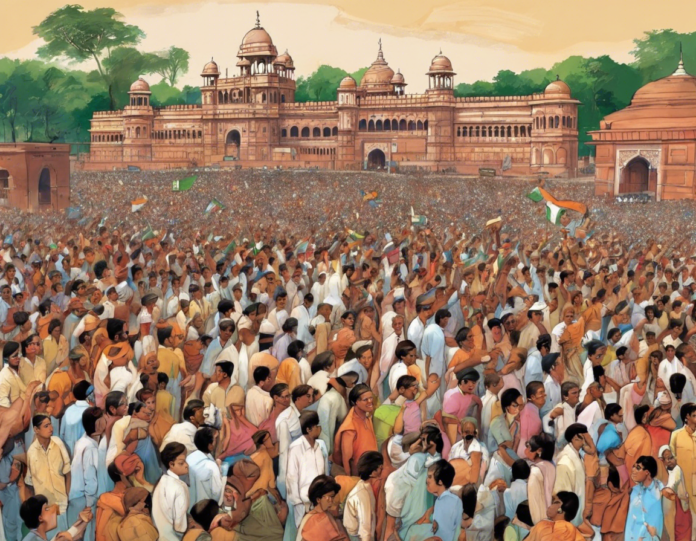India’s federal system is a cornerstone of its democratic structure that allows for both the division of powers and responsibilities between the Center and the States. For students delving into this topic in their Class 10 studies, understanding the intricacies of India’s federal structure becomes essential. Let’s take a deep dive into the various aspects of India’s federal system, providing comprehensive insights to help students grasp the concept effectively.
Understanding Federalism in India
Federalism in India refers to the distribution of powers and responsibilities between the Union Government (Central Government) and the State Governments. The Constitution of India lays down the framework for this federal structure, clearly defining the powers of each tier of government.
Key Features of India’s Federal System
-
Division of Powers: India follows a three-tier federal system where powers are divided between the Union, State, and Local Governments.
-
Written Constitution: The Indian Constitution clearly demarcates the powers of the Union and States in the Seventh Schedule.
-
Independent Judiciary: The judiciary acts as the guardian of the Constitution and ensures a smooth functioning of the federal structure.
-
Rigid Constitution: Amendments to the federal provisions require the consent of both the Union and the States, making it a rigid Constitution.
-
Dual Polity: India has a dual polity system with both the Union and State Governments functioning independently within their domains.
Powers of the Union and States
In India’s federal system, certain powers are exclusive to the Union Government, some to the State Governments, while others are concurrent, i.e. shared by both. It is crucial for students to understand the distribution of powers to appreciate how the government functions at both levels.
Union List, State List, and Concurrent List
-
Union List: This list includes subjects such as defense, foreign affairs, banking, and currency, which are under the exclusive jurisdiction of the Union Government.
-
State List: Subjects like police, public health, agriculture, and local governments fall under the exclusive control of the State Governments as per the State List.
-
Concurrent List: Both the Union and States can make laws on subjects in this list, including education, forests, trade unions, and marriage.
Significance of Federalism in India
Federalism plays a vital role in India’s governance structure, ensuring a balance of power and fostering cooperation between the Centre and the States. Understanding the significance of federalism provides students with insights into how the country’s diverse needs and interests are catered to within this framework.
Importance of Federalism
-
Unity in Diversity: Federalism accommodates the diverse cultural, linguistic, and regional diversity of India, promoting unity.
-
Administrative Efficiency: Decentralization of power leads to effective governance and better management of resources at the grassroots level.
-
Checks and Balances: Federalism ensures that no single authority becomes too powerful by distributing powers among different levels of government.
-
Conflict Resolution: Resolving conflicts between different regions or communities is easier in a federal structure through negotiations and consensus-building.
Challenges in India’s Federal System
While federalism has many advantages, it also poses certain challenges that need to be addressed for a more efficient governance system. Class 10 students exploring this topic should be aware of the hurdles and complexities that the federal framework faces in India.
Challenges in Federalism
-
Financial Imbalance: Disparities in revenue generation and allocation between States can lead to financial imbalances.
-
Inter-State Disputes: Conflicts over water resources, border issues, and jurisdiction often arise between States, requiring intervention for resolution.
-
Political Interference: Central government interference in State matters can strain the federal structure and lead to conflicts.
-
Coordination Issues: Cooperation and coordination between different levels of government are essential for effective governance, but they can be challenging to achieve.
Federalism and Cooperative Federalism
In recent years, the concept of cooperative federalism has gained prominence in India’s governance model. Cooperative federalism emphasizes collaboration and partnership between the Centre and States to address common issues and promote overall development.
Advantages of Cooperative Federalism
-
Team Approach: Promotes a team-based approach where all levels of government work together for the common good.
-
Efficient Resource Allocation: Ensures efficient distribution of resources and benefits to all regions, optimizing developmental outcomes.
-
Policy Consistency: Helps in maintaining policy consistency across different regions, reducing disparities and promoting uniform growth.
-
Enhanced Governance: Encourages transparency, accountability, and good governance practices at both the Union and State levels.
Frequently Asked Questions (FAQs)
1. What is the role of the Inter-State Council in India’s federal system?
The Inter-State Council is a constitutional body that facilitates cooperative federalism by discussing and resolving issues between the Centre and States.
2. How does federalism promote decentralization in India?
Federalism decentralizes power to States and local bodies, allowing for better governance, service delivery, and administration tailored to local needs.
3. Can States challenge the constitutionality of Union laws in India?
Yes, States can challenge the constitutionality of Union laws if they encroach upon State subjects or violate the principles of federalism outlined in the Constitution.
4. What is the significance of the Sarkaria Commission in the context of Indian federalism?
The Sarkaria Commission recommendations aimed to improve center-state relations, resolve disputes, and strengthen cooperative federalism in India.
5. How does federalism contribute to democratic governance in India?
Federalism ensures a distribution of powers, prevents the concentration of authority, and facilitates participatory democracy by accommodating regional aspirations and interests.
In conclusion, understanding India’s federal system is crucial for Class 10 students to comprehend the country’s governance structure comprehensively. From the distribution of powers to the challenges and significance of federalism, exploring these aspects provides students with a holistic view of India’s diverse and dynamic federal framework. By grasping the nuances of federalism and its role in cooperative governance, students can appreciate the complexities and strengths of India’s federal system, paving the way for informed citizenship and active participation in the democratic process.

